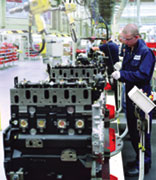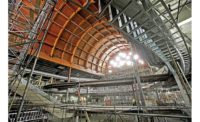 |
| Double Duty. Versatile track option takes the place of wheels on existing skid-steer loaders. (Photo courtesy of Loegering Manufacturing Inc.) |
Some logistical challenges are dampening the excitement. New equipment is rolling out of factories fast, although the rate is starting to subside. Owners who are waiting patiently to have new machines delivered are getting frustrated.
Last year, producers and dealers sold an impressive 24.4% more new machinery than in 2003. Many say they expect to beat sales again in 2005, but only by 5 to 15%. Some blame super-heated sales in 2004 on a U.S. tax provision for bonus depreciation of capital assets, which expired in December.
Heavy machines used for construction and mining are in short supply, as are consumables, such as tires. Dealers are fighting the battle of longer delivery times seen in 2004. A likely sea change will come mid-year as orders catch up, but project owners, contractors and government agencies still need to plan ahead to anticipate the lag time, observers say. That could prove especially difficult for public projects awaiting funds.
"Our main thoughts at the moment are tunnel-boring machines," says Don Phillips, a New York City-based principal engineer for Arup. Along with joint-venture partner DMJM+Harris, Arup is drafting preliminary designs for the Metropolitan Transportation Authority in New York. Funding for the agencys proposed $16-billion, 8.5-mile Second Ave. Subway line in East Manhattan still is tied up, Phillips remarks.
 |
| Bolting. Manufacturers are cranking away to get construction machinery out the door. (Photo courtesy of Perkins Engines Co. Ltd.) |
Pricing Pressures
Consequently, used equipment made a huge comeback last year. Ben Hanna, senior manager of eBays construction category, says the San Jose, Calif.-based Internet site is seeing "the same kind of tightening of supply and the rise of list prices" as seen in new equipment. Hanna says sales are so good at eBay that the $3.27-billion-a-year company plans to drop closing fees for construction items to a flat 1% with a $270 cap, starting Feb. 18. That compares with the normal 8 to 12% commission that auctioneers typically charge. The online trading site for the construction industry has about 2.5 million active users who buy and sell equipment at a rate of one item every nine minutes.
Meanwhile, dealers "are all complaining about product availability, but not about prices," says Frank Manfredi, an equipment industry analyst in Mundelein, Ill. "They say customers have finally believed that machines are hard to get, steel prices have gone up and that they have to accept price increases." Compact equipment is more available than machines like haul trucks and large excavators, he notes. In 2004, sales for new hydraulic excavators in the U.S. climbed 42%.
Manufacturers are working hard to crank out the iron, but they also are feeling the squeeze of higher labor, research, material and energy costs on the input side. Even though Caterpillar Inc., Peoria, Ill., brought in fourth-quarter revenue of $8.57 billion and year-end sales of $30.25 billion, its earnings per share fell short of Wall Street expectations.
For every two steps forward, the manufacturing sector takes three steps back. And steel is still a big variable in the equation. For Cat, higher list prices in the fourth quarter accounted to a top-line earnings increase of 37¢ per share over the previous year. However, higher material costs had a negative impact of 43¢, according to security analysts at Merrill Lynch & Co., New York City. "Cat has pricing power, but it cant seem to control its costs as much as Wall Street would like it to," Manfredi says. "Im guessing that well see some moderation of steel prices toward the middle of the year."
Another problem could get in the way of suppliers meeting customers expectations of quality. If producers let quality-control checks slip in their frenzied rush to get iron out the door, then the potential for manufacturing defects could deal a blow to reputable brand names.
That sounds like a familiar motif in the automotive sector, an industry governed by similar pressures as the equipment business. Since January, General Motors Corp. has recalled 98,221 Chevy and GMC pick-up trucks and SUVs. Mack Trucks Inc. recalled 15,685, Class-8 heavy-duty trucks. And the king of pick-ups, Ford Motor Co., on Jan. 27 recalled 738,490 model F-150s, Supercrew trucks and SUVs. Quality, it would seem, has some room for improvement.
 |
| Reaching Out. Manufacturers are moving rapidly into smaller machines, operator aids and attachments. (Photo courtesy of Ingersoll-Rand CO.) |
Colorful Choices
The new wave of equipment options promises to improve productivity on jobsites. Terry Howard, director of equipment operations for ASRC Energy Services, a pipeline contractor in Anchorage, Alaska, is finding more machinery and tools that match his problems. "We do have more choices. Not just big jumps in sizes, but we can get more intermediate classes as well," he says.
The broad spectrum of equipment on the market today is a multicolored rainbow, not just "yellow" iron. Howard plans to check out new models and meet up with fellow equipment managers at the largest construction event of the year, the upcoming Conexpo-Con/Agg show held this March in...
f construction equipment sales serve as an indicator of the overall health of the industry, then 2005 will be a softer, more-predictable version of 2004. Across the board, manufacturers, dealers, rental outlets and auctioneers are enjoying higher prices, robust demand and thicker backlogs. Their product lines are diversifying and innovation has come back with a vengeance. Construction fleet owners needing to bulk up on rolling stock and tools have more options than ever before.

Post a comment to this article
Report Abusive Comment